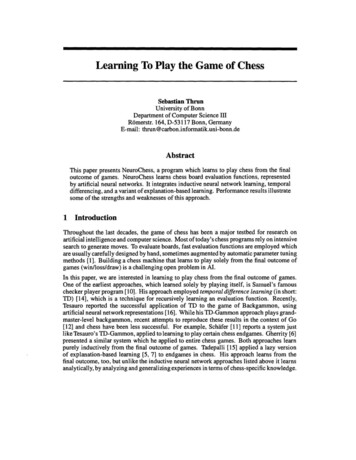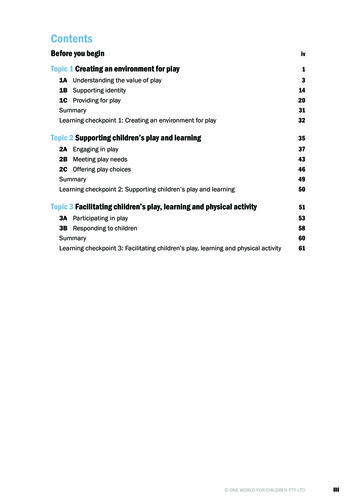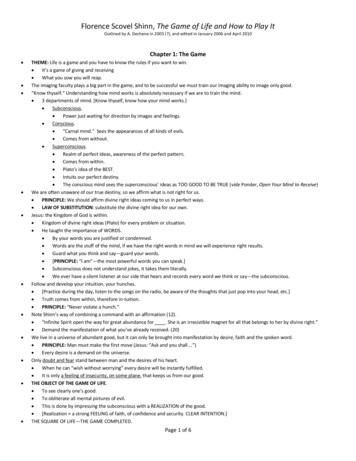
Transcription
Learning To Play the Game of ChessSebastian ThrunUniversity of BonnDepartment of Computer Science IIIRomerstr. 164, 0-53117 Bonn, GermanyE-mail: thrun@carbon.informatik.uni-bonn.deAbstractThis paper presents NeuroChess, a program which learns to play chess from the finaloutcome of games. NeuroChess learns chess board evaluation functions, representedby artificial neural networks. It integrates inductive neural network learning, temporaldifferencing, and a variant of explanation-based learning. Performance results illustratesome of the strengths and weaknesses of this approach.1 IntroductionThroughout the last decades, the game of chess has been a major testbed for research onartificial intelligence and computer science. Most oftoday's chess programs rely on intensivesearch to generate moves. To evaluate boards, fast evaluation functions are employed whichare usually carefully designed by hand, sometimes augmented by automatic parameter tuningmethods [1]. Building a chess machine that learns to play solely from the final outcome ofgames (win/loss/draw) is a challenging open problem in AI.In this paper, we are interested in learning to play chess from the final outcome of games.One of the earliest approaches, which learned solely by playing itself, is Samuel's famouschecker player program [10]. His approach employed temporal difference learning (in short:TO) [14], which is a technique for recursively learning an evaluation function . Recently,Tesauro reported the successful application of TO to the game of Backgammon, usingartificial neural network representations [16]. While his TO-Gammon approach plays grandmaster-level backgammon, recent attempts to reproduce these results in the context of Go[12] and chess have been less successful. For example, Schafer [11] reports a system justlike Tesauro's TO-Gammon, applied to learning to play certain chess endgames. Gherrity [6]presented a similar system which he applied to entire chess games. Both approaches learnpurely inductively from the final outcome of games. Tadepalli [15] applied a lazy versionof explanation-based learning [5, 7] to endgames in chess. His approach learns from thefinal outcome, too, but unlike the inductive neural network approaches listed above it learnsanalytically, by analyzing and generalizing experiences in terms of chess-specific knowledge.
1070Sebastian ThrunThe level of play reported for all these approaches is still below the level of GNU-Chess, apublicly available chess tool which has frequently been used as a benchmark. This illustratesthe hardness of the problem of learning to play chess from the final outcome of games.This paper presents NeuroChess, a program that learns to play chess from the final outcomeof games. The central learning mechanisms is the explanation-based neural network (EBNN)algorithm [9, 8]. Like Tesauro's TD-Gammon approach, NeuroChess constructs a neuralnetwork evaluation function for chess boards using TO. In addition, a neural network versionof explanation-based learning is employed, which analyzes games in terms of a previouslylearned neural network chess model. This paper describes the NeuroChess approach, discusses several training issues in the domain of chess, and presents results which elucidatesome of its strengths and weaknesses.2Temporal Difference Learning in the Domain of ChessTemporal difference learning (TO) [14] comprises a family of approaches to prediction incases where the event to be predicted may be delayed by an unknown number of time steps.In the context of game playing, TD methods have frequently been applied to learn functionswhich predict the final outcome of games. Such functions are used as board evaluationfunctions.The goal of TO(O), a basic variant of TO which is currently employed in the NeuroChessapproach, is to find an evaluation function, V, which ranks chess boards according to theirgoodness: If the board S is more likely to be a winning board than the board Sf, thenV(s) V(Sf). To learn such a function, TO transforms entire chess games, denoted bya sequence of chess boards So, SI, s2, . . . , StunaJ' into training patterns for V. The TO(O)learning rule works in the following way. Assume without loss of generality we are learningwhite's evaluation function. Then the target values for the final board is given by{I,0,-1,if Stu.»tI is a win for whiteif StUnaJ is a drawif StonaJ is a loss for whiteand the targets for the intermediate chess boards So, SI , S2, . . , Stu.»tI-2 are given byVt.1fget( St)I· V (St 2) (1)(2)This update rule constructs V recursively. At the end of the game, V evaluates the finaloutcome of the game (Eq. (l In between, when the assignment of V -values is less obvious,V is trained based on the evaluation two half-moves later (Eq. (2». The constant I (witho I 1) is a so-called discount factor. It decays V exponentially in time and hencefavors early over late success. Notice that in NeuroChess V is represented by an artificialneural network, which is trained to fit the target values vtarget obtained via Eqs. (l) and (2)(cj [6, 11, 12, 16]).».3Explanation-Based Neural Network LearningIn a domain as complex as chess, pure inductive learning techniques. such as neural network Back-Propagation, suffer from enormous training times. To illustrate why, considerthe situation of a knight fork. in which the opponent's knight attacks our queen and kingsimultaneously. Suppose in order to save our king we have to move it, and hence sacrificeour queen. To learn the badness of a knight fork, NeuroChess has to discover that certainboard features (like the position of the queen relative to the knight) are important, whereas
Learning to Play the Game of Chess1071Figure 1: Fitting values and slopes in EBNN: Let V be the target function for which threeexamples (s\, V(S\)), (S2' V(S2)), and (S3, V(S3)) are known. Based on these points theS2)OS2, and a ;:3) arelearner might generate the hypothesis V'. If the slopes a ;:I),also known, the learner can do much better: V".arothers (like the number of weak pawns) are not. Purely inductive learning algorithms suchas Back-propagation figure out the relevance of individual features by observing statisticalcorrelations in the training data. Hence, quite a few versions of a knight fork have to beexperienced in order to generalize accurately. In a domain as complex as chess, such anapproach might require unreasonably large amounts of training data.Explanation-based methods (EBL) [5, 7, 15] generalize more accurately from less trainingdata. They rely instead on the availability of domain knowledge, which they use for explainingand generalizing training examples. For example, in the explanation of a knight fork, EBLmethods employ knowledge about the game of chess to figure out that the position of thequeen is relevant, whereas the number of weak pawns is not. Most current approaches toEBL require that the domain knowledge be represented by a set of symbolic rules. SinceNeuroChess relies on neural network representations, it employs a neural network versionof EBL, called explanation-based neural network learning (EBNN) [9]. In the context ofchess, EBNN works in the following way: The domain-specific knowledge is representedby a separate neural network, called the chess model M. M maps arbitrary chess boards Stto the corresponding expected board St 2 two half-moves later. It is trained prior to learningV, using a large database of grand-master chess games. Once trained, M captures importantknowledge about temporal dependencies of chess board features in high-quality chess play.EBNN exploits M to bias the board evaluation function V. It does this by extracting slopeconstraints for the evaluation function V at all non-final boards, i.e., all boards for which Vis updated by Eq. (2). Letwitht E{a, 1,2, . , tlioa\ - 2}denote the target slope of V at St, which, becauseEq. (2), can be rewritten asoV target ( St) 'Y.oV( St 2) OSt 2. OSt 2OStvtarget ( St)(3)is set to 'Y V (St 2) according(4)using the chain rule of differentiation. The rightmost term in Eq. (4) measures how infinitesimal small changes of the chess board St influence the chess board St 2. It can beapproximated by the chess model M:ovtarget(St)OSt 'Y.OV(St 2) oM(st).OSt 2OSt(5)The right expression is only an approximation to the left side, because M is a trained neural
Sebastian Thrun1072 bmrd at timef(W"T" ) board attime 1 I(black to move) board at time 1 2(w"'·ro )predictive model network M165 hidden unit,V(1 2)Figure 2: Learning an evaluation function in NeuroChess. Boards are mapped into ahigh-dimensionalJeature vector, which forms the input for both the evaluation network Vand the chess model M. The evaluation network is trained by Back-propagation and theTD(O) procedure. Both networks are employed for analyzing training example in order toderive target slopes for V.network and thus its first derivative might be erroneous. Notice that both expressions onthe right hand side of Eq. (5) are derivatives of neural network functions, which are easy tocompute since neural networks are differentiable.The result of Eq . (5) is an estimate of the slope of the target function V at 8t . This slopeadds important shape information to the target values constructed via Eq. (2). As depicted inFig. 1, functions can be fit more accurately if in addition to target values the slopes of thesevalues are known. Hence, instead of just fitting the target values vtarget ( 8t), NeuroChess alsofits these target slopes. This is done using the Tangent-Prop algorithm [13].The complete NeuroChess learning architecture is depicted in Fig. 2. The target slopesprovide a first-order approximation to the relevance of each chess board feature in thegoodness of a board position. They can be interpreted as biasing the network V based onchess-specific domain knowledge, embodied in M . For the relation ofEBNN and EBL andthe accommodation of inaccurate slopes in EBNN see [8].4Training IssuesIn this section we will briefly discuss some training issues that are essential for learning goodevaluation functions in the domain of chess. This list of points has mainly been producedthrough practical experience with the NeuroChess and related TD approaches. It illustratesthe importance of a careful design of the input representation, the sampling rule and the
Learning to Play the Game of Chess1073parameter setting in a domain as complex as chess.Sampling. The vast majority of chess boards are, loosely speaking, not interesting. If, forexample, the opponent leads by more than a queen and a rook, one is most likely to loose.Without an appropriate sampling method there is the danger that the learner spends mostof its time learning from uninteresting examples. Therefore, NeuroChess interleaves selfplay and expert play for guiding the sampling process. More specifically, after presentinga random number of expert moves generated from a large database of grand-master games,NeuroChess completes the game by playing itself. This sampling mechanism has been foundto be of major importance to learn a good evaluation function in a reasonable amount of time.Quiescence. In the domain of chess certain boards are harder to evaluate than others. Forexample, in the middle of an ongoing material exchange, evaluation functions often fail toproduce a good assessment. Thus, most chess programs search selectively. A commoncriterion for determining the depth of search is called quiescence. This criterion basicallydetects material threats and deepens the search correspondingly. NeuroChess' search enginedoes the same. Consequently, the evaluation function V is only trained using quiescentboards.Smoothness. Obviously, using the raw, canonical board description as input representation isa poor choice. This is because small changes on the board can cause a huge difference in value,contrasting the smooth nature of neural network representations. Therefore, NeuroChessmaps chess board descriptions into a set of board features . These features were carefullydesigned by hand.Discounting. The variable 'Y in Eq. (2) allows to discount values in time. Discounting hasfrequently been used to bound otherwise infinite sums of pay-off. One might be inclined tothink that in the game of chess no discounting is needed, as values are bounded by definition.Indeed, without discounting the evaluation function predicts the probability for winning-inthe ideal case. In practice, however, random disturbations of the evaluation function canseriously hurt learning, for reasons given in [4, 17]. Empirically we found that learningfailed completely when no discount factor was used. Currently, NeuroChess uses 'Y 0.98.Learning rate. TO approaches minimize a Bellman equation [2]. In the NeuroChessdomain, a close-to-optimal approximation of the Bellman equation is the constant functionV(s) O. This function violates the Bellman equation only at the end of games (Eq. (1»,which is rare if complete games are considered. To prevent this, we amplified the learningrate for final values by a factor of20, which was experimentally found to produce sufficientlynon-constant evaluation functions.Software architecture. Training is performed completely asynchronously on up to 20workstations simultaneously. One of the workstations acts as a weight server, keeping trackof the most recent weights and biases of the evaluation network. The other workstationscan dynamically establish links to the weight server and contribute to the process of weightrefinement. The main process also monitors the state of all other workstations and restartsprocesses when necessary. Training examples are stored in local ring buffers (1000 itemsper workstation).5ResultsIn this section we will present results obtained with the NeuroChess architecture. Prior tolearning an evaluation function, the model M (175 input, 165 hidden, and 175 output units)is trained using a database of 120,000 expert games. NeuroChess then learns an evaluation
1074I. e2e3 b8c62. dlf3 c6e53. f3d5 d7d64. flb5 c7c65. b5a4 g8f66. d5d4 c8f57. f2f4 e5d78. ele2d8a59. a4b3 d7c510. b I a3 c5b311 . a2b3 e7e512. f4e5 f6e413. e5d6 e8c814. b3b4 a5a615. b4b5 a6a5Sebastian Thrun16. b2b4 a5a417. b5c6 a4c618. gl f3 d8d619. d4a7 f5g420. c2c4 c8d721. b4b5 c6c722. d2d3 d6d323. b5b6 c7c624. e2d3 e4f225. d3c3 g4f326. g2f3 f2h 127. clb2 c6f328. a7a4 d7e729. a3c2 hi f230. b2a3 e7f631 . a3f8 f2e432. c3b2 h8f833. a4d7 f3f534. d7b7 f5e535. b2cl f8e836. b7d5 e5h237. ala7 e8e638. d5d8 f6g639. b6b7 e6d640. d8a5 d6c641 . a5b4 h2b842. a7a8 e4c343. c2d4 c6f644. b4e7 c3a245. cldl a2c346. d I c2 b8h247. c2c3 f6b648. e7e4 g6h649. d4f5 h6g550. e4e7 g5g451. f5h6 g7h652. e7d7 g4h553. d7d I h5h454. d I d4 h4h355. d4b6 h2e556. b6d4 e5e657. c3d2 e6f558. e3e4 f5 g559. d4e3 g5e360. d2e3 f7f561 . e4f5 h3g4 65. a8e8 e6d762. f5f6 h6h566. e8e7 d7d863. b7b8q g4f5 67. f4c764. b8f4 f5e6final boardFigure 3: NeuroChess against GNU-Chess. NeuroChess plays white. Parameters: Bothplayers searched to depth 3, which could be extended by quiescence search to at most 11.The evaluation network had no hidden units. Approximately 90% of the training boardswere sampled from expert play.network V (175 input units, 0 to 80 hidden units, and one output units). To evaluate the levelof play, NeuroChess plays against GNU-Chess in regular time intervals. Both players employthe same search mechanism which is adopted from GNU-Chess. Thus far, experiments lastedfor 2 days to 2 weeks on I to 20 SUN Sparc Stations.A typical game is depicted in Fig. 3. This game has been chosen because it illustrates boththe strengths and the shortcomings of the NeuroChess approach. The opening of NeuroChessis rather weak. In the first three moves NeuroChess moves its queen to the center of theboard.' NeuroChess then escapes an attack on its queen in move 4, gets an early pawnadvantage in move 12, attacks black's queen pertinaciously through moves 15 to 23, andsuccessfully exchanges a rook. In move 33, it captures a strategically important pawn, which,after chasing black's king for a while and sacrificing a knight for no apparent reason, finallyleads to a new queen (move 63). Four moves later black is mate. This game is prototypical.As can be seen from this and various other games, NeuroChess has learned successfully toprotect its material, to trade material, and to protect its king. It has not learned, however, toopen a game in a coordinated way, and it also frequently fails to play short.endgames evenif it has a material advantage (this is due to the short planning horizon). Most importantly, itstill plays incredibly poor openings, which are often responsible for a draw or a loss. Pooropenings do not surprise, however, as TD propagates values from the end of a game to thebeginning.Table I shows a performance comparison of NeuroChess versus GNU-Chess, with andwithout the explanation-based learning strategy. This table illustrates that NeuroChess winsapproximately 13% of all games against GNU-Chess, if both use the same search engine. It'This is because in the current version NeuroChess still heavily uses expert games for sampling.Whenever a grand-master moves its queen to the center of the board, the queen is usually safe, and thereis indeed a positive correlation between having the queen in the center and winning in the database.NeuroChess falsely deduces that having the queen in the center is good. This effect disappears whenthe level of self-play is increased, but this comes at the expense of drastically increased training time,since self-play requires search.
Learning to Play the Game of Chess# of games1002005001000150020002400GNU depth 2, NeuroChess depth 61075GNU depth 4, NeuroChess depth 2Back-propagationEBNN0000I0213338II3Table 1: Performance ofNeuroChess vs. GNU-Chess during training. The numbers show thetotal number of games won against GNU-Chess using the same number of games for testingas for training. This table also shows the importance of the explanation-based learningstrategy in EBNN. Parameters: both learners used the original GNU-Chess features, theevaluation network had 80 hidden units and search was cut at depth 2, or 4, respectively (noquiescence extensions).also illustrates the utility of explanation-based learning in chess.6 DiscussionThis paper presents NeuroChess, an approach for learning to play chess from the finaloutcomes of games. NeuroChess integrates TD, inductive neural network learning anda neural network version of explanation-based learning. The latter component analyzesgames using knowledge that was previously learned from expert play. Particular care hasbeen taken in the design of an appropriate feature representation, sampling methods, andparameter settings. Thus far, NeuroChess has successfully managed to beat GNU-Chess inseveral hundreds of games. However, the level of play still compares poorly to GNU-Chessand human chess players.Despite the initial success, NeuroChess faces two fundamental problems which both mightweB be in the way of excellent chess play. Firstly, training time is limited, and it is tobe expected that excellent chess skills develop only with excessive training time. This isparticularly the case if only the final outcomes are considered. Secondly, with each step ofTO-learning NeuroChess loses information. This is partially because the features used fordescribing chess boards are incomplete, i.e., knowledge about the feature values alone doesnot suffice to determine the actual board exactly. But, more importantly, neural networks havenot the discriminative power to assign arbitrary values to all possible feature combinations.It is therefore unclear that a TD-like approach will ever, for example, develop good chessopenmgs.Another problem of the present implementation is related to the trade-off between knowledgeand search. It has been well recognized that the ul timate cost in chess is determi ned by the ti meit takes to generate a move. Chess programs can generally invest their time in search, or in theevaluation of chess boards (search-knowledge trade-off) [3] . Currently, NeuroChess does apoor job, because it spends most of its time computing board evaluations. Computing a largeneural network function takes two orders of magnitude longer than evaluating an optimizedlinear evaluation function (like that of GNU-Chess). VLSI neural network technology offersa promising perspective to overcome this critical shortcoming of sequential neural networksimulations.
1076Sebastian ThrunAcknowledgmentThe author gratefully acknowledges the guidance and advise by Hans Berliner, who providedthe features for representing chess boards, and without whom the current level of play wouldbe much worse. He also thanks Tom Mitchell for his suggestion on the learning methods,and Horst Aurisch for his help with GNU-Chess and the database.References[I] Thomas S. Anantharaman. A Statistical Study of Selective Min-Max Search in Computer Chess.PhD thesis, Carnegie Mellon University, School of Computer Science, Pittsburgh, PA, 1990.Technical Report CMU-CS-90-173.[2] R. E. Bellman. Dynamic Programming. Princeton University Press, Princeton, NJ, 1957.[3] Hans J. Berliner, Gordon Goetsch, Murray S. Campbell, and Carl Ebeling. Measuring theperformance potential of chess programs. Artificial Intelligence, 43:7-20, 1990.[4] Justin A. Boyan. Generalization in reinforcement learning: Safely approximating the valuefunction. In G. Tesauro, D. Touretzky, and T. Leen, editors, Advances in Neural InformationProcessing Systems 7, San Mateo, CA, 1995. Morgan Kaufmann. (to appear).[5] Gerald Dejong and Raymond Mooney. Explanation-based learning: An alternative view. Machine Learning, 1(2): 145-176, 1986.[6] Michael Gherrity. A Game-Learning Machine. PhD thesis, University of California, San Diego,1993.[7] Tom M. Mitchell, Rich Keller, and Smadar Kedar-Cabelli. Explanation-based generalization: Aunifying view. Machine Learning, 1(1 ):47-80, 1986.[8] Tom M. Mitchell and Sebastian Thrun. Explanation based learning: A comparison of symbolicand neural network approaches. In Paul E. Utgoff, editor, Proceedings of the Tenth InternationalConference on Machine Learning, pages 197-204, San Mateo, CA, 1993. Morgan Kaufmann.[9] Tom M. Mitchell and Sebastian Thrun. Explanation-based neural network learning for robotcontrol. In S. J. Hanson, J. Cowan, and C. L. Giles, editors, Advances in Neural InformationProcessing Systems 5, pages 287-294, San Mateo, CA, 1993. Morgan Kaufmann.[10] A. L. Samuel. Some studies in machine learning using the game of checkers. IBM Journal onresearch and development, 3:210-229, 1959.[11] Johannes Schafer. Erfolgsorientiertes Lemen mit Tiefensuche in Bauemendspielen. Technicalreport, UniversiUit Karlsruhe, 1993. (in German).[12] Nikolaus Schraudolph, Pater Dayan, and Terrence J. Sejnowski. Using the TD(lambda) algorithmto learn an evaluation function for the game of go. In Advances in Neural Information ProcessingSystems 6, San Mateo, CA, 1994. Morgan Kaufmann.[13] Patrice Simard, Bernard Victorri, Yann LeCun, and John Denker. Tangent prop -a formalism forspecifying selected invariances in an adaptive network. In J. E. Moody, S. J. Hanson, and R. P.Lippmann, editors, Advances in Neural Information Processing Systems 4, pages 895-903, SanMateo, CA, 1992. Morgan Kaufmann.[14] Richard S. Sutton. Learning to predict by the methods of temporal differences. Machine Learning,3,1988.[15] Prasad Tadepalli. Planning in games using approximately learned macros. In Proceedings of theSixth International Workshop on Machine Learning, pages 221-223, Ithaca, NY, 1989. MorganKaufmann.[16] Gerald J. Tesauro. Practical issues in temporal difference learning. Machine Learning, 8, 1992.[17] Sebastian Thrun and Anton Schwartz. Issues in using function approximation for reinforcement learning. In M. Mozer, P. Smolensky, D. Touretzky, J. Elman, and A. Weigend, editors,Proceedings of the 1993 Connectionist Models Summer School, Hillsdale, NJ, 1993. ErlbaumAssociates.
methods [1]. Building a chess machine that learns to play solely from the final outcome of games (win/loss/draw) is a challenging open problem in AI. In this paper, we are interested in learning to play chess from the final outcome of games. One of the earliest approaches, w











